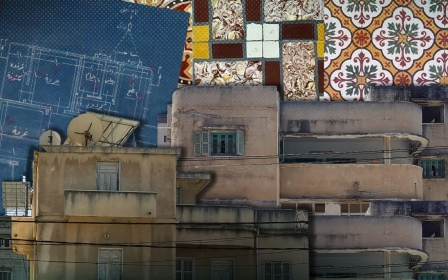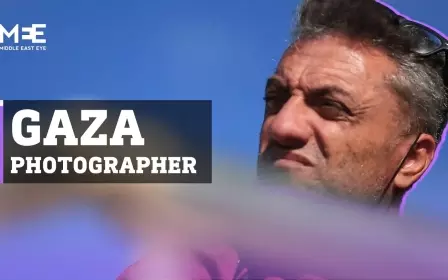In pictures: Beirut Image Festival makes a triumphant return despite Lebanon's economic crisis
This month, the annual Beirut Image Festival made a welcome return after a two-year hiatus as a result of the coronavirus pandemic.
The festival features photographs from both local and international photographers, and is held across Beirut and other major cities, including Tripoli, Sidon, Sour and Baalbek.
The festival was first launched in 2019, a collaboration between the Image Festival Associate and the Union of Arab Photographers.
The theme behind this year’s festival was "memory", with photographers encouraged to submit entries revolving around their interpretation of that word. Submissions included everything from historical and archival images to personal experiences, including family stories and cultural traditions.
The event launch paid an emotional tribute to Palestinian-American journalist Shireen Abu Akleh, who was killed by Israeli forces earlier this year. In the tribute, photos were shown alongside the documentary The Last Encounter, a documentary by Al Jazeera which documents Abu Akleh's coverage of the tensions in Palestine, the threats from Israeli settlers and the occupation as well as her journalistic work and the threats against it.
Lebanon's Minister of Culture Mohammed Wisam al-Mortada was present at the tribute, where he spoke about Abu Akleh's work and the importance of her journalism in revealing more about the injustices in Palestine, and how her career was symbolic for many. (All photographs by Omar Hamesh. The main picture is a photograph of an iconic image displayed at the festival by Alfred Yaghobzadeh of a young Iranian Basij fighter, taken in March 1981.)
The main purpose behind the festival was to provide both budding and professional photographers a space to share their work.
By bringing together local and international photographers, the festival’s organisers said that it allows them to share ideas, develop their work further and meet other like-minded people in the same field.
Ibrahim Dirani, the festival's project manager, told Middle East Eye that the exhibition was about more than just displaying powerful photos.
"As photographers and people involved in the arts and culture scene, we see this festival as more of an act of resistance, especially in a country devastated by wars, conflicts and injustices," he explained.
"In the context of Lebanon, we have suffered from the economic crisis and a catastrophic blast where the effects still linger on. In this depressing environment, we can only do what we know how to do and set an example," he added.
Festival directors Ramzi Haider and Sherin Yazbek said that this year’s festival was particularly noteworthy.
“This is the first time a festival like this in the region had international participants too,” Haider told local media, al-Jadeed TV. “We also managed to get through two years of challenges, including the coronavirus pandemic and the economic crisis. This year, we didn’t have the same support we did back in 2019 because of the economic challenges,” he added.
According to Haider, over 500 photographers submitted their work from around the world to the festival, and despite the considerable financial challenges they faced, they were determined to continue on with the festival.
“We had to close submissions after three months because we didn’t have the capacity to deal with it all, but we wanted to keep this project going even if there wasn’t support for it. After all, Beirut is a cultural centre and a hub for all types of art,” he said.
Over 30 photographers from around the world, including the UK, US, Tunisia and Palestine contributed to the exhibition which was open to the public throughout the month of September.
Yazbek explained that the exhibition was important in raising awareness on important issues within the country.
“We wanted to use the photos so we don’t forget the martyrs from the Beirut port blast and what happened, we seem to sometimes be living in a state of amnesia here,” she said. “The problem with issues in Lebanon is that you will often find that we forget, cover and erase, we don’t reflect on what happened,” she added.
The exhibition also focused on other countries around the region. One installation Palestine… Life Through the Eyes of Photographer Khalil Raad is comprised of a selection of old photographs, intended to give an insight into the daily life and landscape in Palestine, prior to the Nakba of 1948, also referred to as the Catastrophe, where over 750,000 Palestinians were forcibly displaced from their homes.
Raad, born in Lebanon in 1854, was a prominent photographer who documented life in Lebanon, Palestine and Syria over a period of 50 years. His photography studio, based in Palestine, was destroyed during attacks by Israeli forces in 1948.
However, he continued to document Palestinian life and culture in detail until his death in 1957, in an effort to steer away from the Eurocentric and colonial gaze present in the photography at the time. He instead tried to provide an authentic view of Palestine’s urban, cultural and economic scenes.
This image, taken in April 1985, shows a Lebanese liberated prisoner hugging his sister after arriving at the port city of Sidon. He was among the hundreds of people seized by Israeli troops in southern Lebanon during the South Lebanon conflict from 1985-2000.
According to Dirani, the festival had a large audience, despite economic worries.
"In general, we expected less people to show up because of the insane fuel prices. But we could see that people from different artistic, economic and social backgrounds were thirsty for cultural content," he said.
This image, from an exhibition titled Tehran, Jerusalem, Beirut: A journey by Alfred was produced by Alfred Yaghobzadeh, an Iranian photographer known for photographing turbulent and tense periods in Tehran.
As well as featuring war photography and archive images, the exhibition also highlighted Lebanon’s rich culture and heritage.
The exhibition Witness to the Golden Years, focused on Beirut’s Hamra area, displayed unpublished images of Arab stars. This included images of the renowned singer Fayrouz, as well as Egyptian singer Oum Kulthum, Sabah and Faten Hamama.
Dirani said that despite the challenges and continued difficulties many in the country are experiencing, the festival hopes to come back better and stronger in the future.
"We'll be making the next call for entries in 2023, and hope to tackle any obstacles that come our way as well as collaborate with more cultural spaces, initiatives and universities."
Middle East Eye delivers independent and unrivalled coverage and analysis of the Middle East, North Africa and beyond. To learn more about republishing this content and the associated fees, please fill out this form. More about MEE can be found here.




